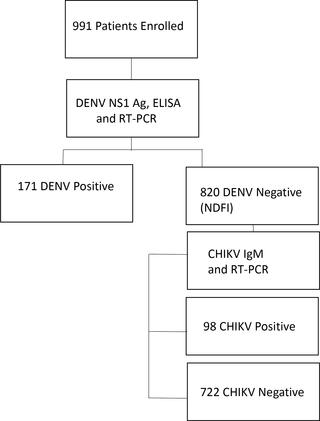当前位置:
X-MOL 学术
›
PLOS Negl. Trop. Dis.
›
论文详情
Our official English website, www.x-mol.net, welcomes your
feedback! (Note: you will need to create a separate account there.)
Comparison of clinical presentation and out-comes of Chikungunya and Dengue virus infections in patients with acute undifferentiated febrile illness from the Sindh region of Pakistan.
PLOS Neglected Tropical Diseases ( IF 3.4 ) Pub Date : 2020-03-23 , DOI: 10.1371/journal.pntd.0008086 Uzma Shahid 1 , Joveria Q Farooqi 1 , Kelli L Barr 2 , S Faisal Mahmood 3 , Bushra Jamil 3 , Kehkashan Imitaz 1 , Zahida Azizullah 1 , Faisal R Malik 1 , Dhani Prakoso 4 , Maureen T Long 4 , Erum Khan 1
PLOS Neglected Tropical Diseases ( IF 3.4 ) Pub Date : 2020-03-23 , DOI: 10.1371/journal.pntd.0008086 Uzma Shahid 1 , Joveria Q Farooqi 1 , Kelli L Barr 2 , S Faisal Mahmood 3 , Bushra Jamil 3 , Kehkashan Imitaz 1 , Zahida Azizullah 1 , Faisal R Malik 1 , Dhani Prakoso 4 , Maureen T Long 4 , Erum Khan 1
Affiliation

|
BACKGROUND
Arboviruses are a cause of acute febrile illness and outbreaks worldwide. Recent outbreaks of Chikungunya virus (CHIKV) in dengue endemic areas have alarmed clinicians as unique clinical features differentiating CHIKV from Dengue virus (DENV) are limited. This has complicated diagnostic efforts especially in resource limited countries where lab testing is not easily available. Therefore, it is essential to analyse and compare clinical features of laboratory confirmed cases to assist clinicians in suspecting possible CHIKV infection at time of clinical presentation.
METHODOLOGY
A prospective point prevalence study was conducted, with the hypothesis that not all patients presenting with clinical suspicion of dengue infections at local hospitals are suffering from dengue and that other arboviruses such as Chikungunya, West Nile viruses, Japanese Encephalitis virus and Zika virus are co-circulating in the Sindh region of Pakistan. Out-patients and hospitalized (in-patients) of selected district hospitals in different parts of Sindh province of Pakistan were recruited. Patients with presumptive dengue like illness (Syndromic diagnosis) by the treating physicians were enrolled between 2015 and 2017. Current study is a subset of larger study mentioned above. Here-in we compared laboratory confirmed cases of CHIKV and DENV to assess clinical features and laboratory findings that may help differentiate CHIKV from DENV infection at the time of clinical presentation.
RESULTS
Ninety-eight (n = 98) cases tested positive for CHIKV, by IgM and PCR and these were selected for comparative analysis with DENV confirmed cases (n = 171). On multivariable analysis, presence of musculoskeletal [OR = 2.5 (95% CI:1.6-4.0)] and neurological symptoms [OR = 4.4 (95% CI:1.9-10.2)], and thrombocytosis [OR = 2.2 (95% CI:1.1-4.0)] were associated with CHIKV infection, while atypical lymphocytes [OR = 8.3 (95% CI:4.2-16.7)] and thrombocytopenia [OR = 8.1 (95% CI:1.7-38.8)] were associated with DENV cases at time of presentation. These findings may help clinicians in differentiating CHIKV from DENV infection.
CONCLUSION
CHIKV is an important cause of illness amongst patients presenting with acute febrile illness in Sindh region of Pakistan. Arthralgia and encephalitis at time of presentation among patients with dengue-like illness should prompt suspicion of CHIKV infection, and laboratory confirmation must be sought.
中文翻译:

巴基斯坦信德省急性未分化发热性疾病患者基孔肯雅热和登革热病毒感染的临床表现和结果比较。
背景技术虫媒病毒是引起急性发热性疾病并在世界范围内爆发的原因。登革热流行地区最近爆发的基孔肯雅病毒(CHIKV)令临床医生感到震惊,因为区别CHIKV和登革热病毒(DENV)的独特临床特征十分有限。这使诊断工作变得很复杂,尤其是在资源有限的国家/地区,那里实验室测试不容易获得。因此,必须分析和比较实验室确诊病例的临床特征,以协助临床医生在临床表现时怀疑可能的CHIKV感染。方法进行了一项前瞻性流行病学研究,其假设是,并非所有在当地医院表现出临床怀疑为登革热感染的患者都患有登革热,而其他虫媒病毒如基孔肯雅热,西尼罗河病毒,日本脑炎病毒和寨卡病毒在巴基斯坦信德省共同流行。招募了巴基斯坦信德省不同地区的部分地区医院的门诊病人和住院(住院病人)。2015年至2017年之间招募了由主治医生推测患有登革热样疾病(综合症诊断)的患者。本研究是上述较大研究的一部分。在本文中,我们比较了实验室确诊的CHIKV和DENV病例,以评估临床特征和实验室发现,这可能有助于在临床表现时将CHIKV与DENV感染区分开。结果通过IgM和PCR检测,有98例(n = 98)的CHIKV阳性,并与DENV确诊的病例进行比较分析(n = 171)。在多变量分析中,肌肉骨骼[OR = 2.5(95%CI:1.6-4.0)]和神经系统症状[OR = 4.4(95%CI:1.9-10.2)]和血小板增多症[OR = 2.2(95%CI:1.1-4.0) ]与CHIKV感染有关,而非典型淋巴细胞[OR = 8.3(95%CI:4.2-16.7)]和血小板减少症[OR = 8.1(95%CI:1.7-38.8)]与DENV病例在报告时有关。这些发现可能有助于临床医生区分CHIKV和DENV感染。结论CHIKV是巴基斯坦信德省急性发热疾病患者的重要疾病原因。在登革热样疾病患者中出现关节痛和脑炎时,应引起怀疑CHIKV感染,必须寻求实验室确认。和血小板减少症[OR = 2.2(95%CI:1.1-4.0)]与CHIKV感染相关,而非典型淋巴细胞[OR = 8.3(95%CI:4.2-16.7)]和血小板减少症[OR = 8.1(95%CI: 1.7-38.8)]与就诊时的DENV病例有关。这些发现可能有助于临床医生区分CHIKV和DENV感染。结论CHIKV是巴基斯坦信德省急性发热疾病患者的重要疾病原因。在登革热样疾病患者中出现关节痛和脑炎时,应引起怀疑CHIKV感染,必须寻求实验室确认。和血小板减少症[OR = 2.2(95%CI:1.1-4.0)]与CHIKV感染相关,而非典型淋巴细胞[OR = 8.3(95%CI:4.2-16.7)]和血小板减少症[OR = 8.1(95%CI: 1.7-38.8)]与就诊时的DENV病例有关。这些发现可能有助于临床医生区分CHIKV和DENV感染。结论CHIKV是巴基斯坦信德省急性发热疾病患者的重要疾病原因。登革热样疾病患者中出现关节痛和脑炎应提示怀疑CHIKV感染,必须寻求实验室确认。8)]与出现时的DENV病例有关。这些发现可能有助于临床医生区分CHIKV和DENV感染。结论CHIKV是巴基斯坦信德省急性发热疾病患者的重要疾病原因。在登革热样疾病患者中出现关节痛和脑炎时,应引起怀疑CHIKV感染,必须寻求实验室确认。8)]与出现时的DENV病例有关。这些发现可能有助于临床医生区分CHIKV和DENV感染。结论CHIKV是巴基斯坦信德省急性发热疾病患者的重要疾病原因。在登革热样疾病患者中出现关节痛和脑炎时,应引起怀疑CHIKV感染,必须寻求实验室确认。
更新日期:2020-03-24
中文翻译:

巴基斯坦信德省急性未分化发热性疾病患者基孔肯雅热和登革热病毒感染的临床表现和结果比较。
背景技术虫媒病毒是引起急性发热性疾病并在世界范围内爆发的原因。登革热流行地区最近爆发的基孔肯雅病毒(CHIKV)令临床医生感到震惊,因为区别CHIKV和登革热病毒(DENV)的独特临床特征十分有限。这使诊断工作变得很复杂,尤其是在资源有限的国家/地区,那里实验室测试不容易获得。因此,必须分析和比较实验室确诊病例的临床特征,以协助临床医生在临床表现时怀疑可能的CHIKV感染。方法进行了一项前瞻性流行病学研究,其假设是,并非所有在当地医院表现出临床怀疑为登革热感染的患者都患有登革热,而其他虫媒病毒如基孔肯雅热,西尼罗河病毒,日本脑炎病毒和寨卡病毒在巴基斯坦信德省共同流行。招募了巴基斯坦信德省不同地区的部分地区医院的门诊病人和住院(住院病人)。2015年至2017年之间招募了由主治医生推测患有登革热样疾病(综合症诊断)的患者。本研究是上述较大研究的一部分。在本文中,我们比较了实验室确诊的CHIKV和DENV病例,以评估临床特征和实验室发现,这可能有助于在临床表现时将CHIKV与DENV感染区分开。结果通过IgM和PCR检测,有98例(n = 98)的CHIKV阳性,并与DENV确诊的病例进行比较分析(n = 171)。在多变量分析中,肌肉骨骼[OR = 2.5(95%CI:1.6-4.0)]和神经系统症状[OR = 4.4(95%CI:1.9-10.2)]和血小板增多症[OR = 2.2(95%CI:1.1-4.0) ]与CHIKV感染有关,而非典型淋巴细胞[OR = 8.3(95%CI:4.2-16.7)]和血小板减少症[OR = 8.1(95%CI:1.7-38.8)]与DENV病例在报告时有关。这些发现可能有助于临床医生区分CHIKV和DENV感染。结论CHIKV是巴基斯坦信德省急性发热疾病患者的重要疾病原因。在登革热样疾病患者中出现关节痛和脑炎时,应引起怀疑CHIKV感染,必须寻求实验室确认。和血小板减少症[OR = 2.2(95%CI:1.1-4.0)]与CHIKV感染相关,而非典型淋巴细胞[OR = 8.3(95%CI:4.2-16.7)]和血小板减少症[OR = 8.1(95%CI: 1.7-38.8)]与就诊时的DENV病例有关。这些发现可能有助于临床医生区分CHIKV和DENV感染。结论CHIKV是巴基斯坦信德省急性发热疾病患者的重要疾病原因。在登革热样疾病患者中出现关节痛和脑炎时,应引起怀疑CHIKV感染,必须寻求实验室确认。和血小板减少症[OR = 2.2(95%CI:1.1-4.0)]与CHIKV感染相关,而非典型淋巴细胞[OR = 8.3(95%CI:4.2-16.7)]和血小板减少症[OR = 8.1(95%CI: 1.7-38.8)]与就诊时的DENV病例有关。这些发现可能有助于临床医生区分CHIKV和DENV感染。结论CHIKV是巴基斯坦信德省急性发热疾病患者的重要疾病原因。登革热样疾病患者中出现关节痛和脑炎应提示怀疑CHIKV感染,必须寻求实验室确认。8)]与出现时的DENV病例有关。这些发现可能有助于临床医生区分CHIKV和DENV感染。结论CHIKV是巴基斯坦信德省急性发热疾病患者的重要疾病原因。在登革热样疾病患者中出现关节痛和脑炎时,应引起怀疑CHIKV感染,必须寻求实验室确认。8)]与出现时的DENV病例有关。这些发现可能有助于临床医生区分CHIKV和DENV感染。结论CHIKV是巴基斯坦信德省急性发热疾病患者的重要疾病原因。在登革热样疾病患者中出现关节痛和脑炎时,应引起怀疑CHIKV感染,必须寻求实验室确认。











































 京公网安备 11010802027423号
京公网安备 11010802027423号